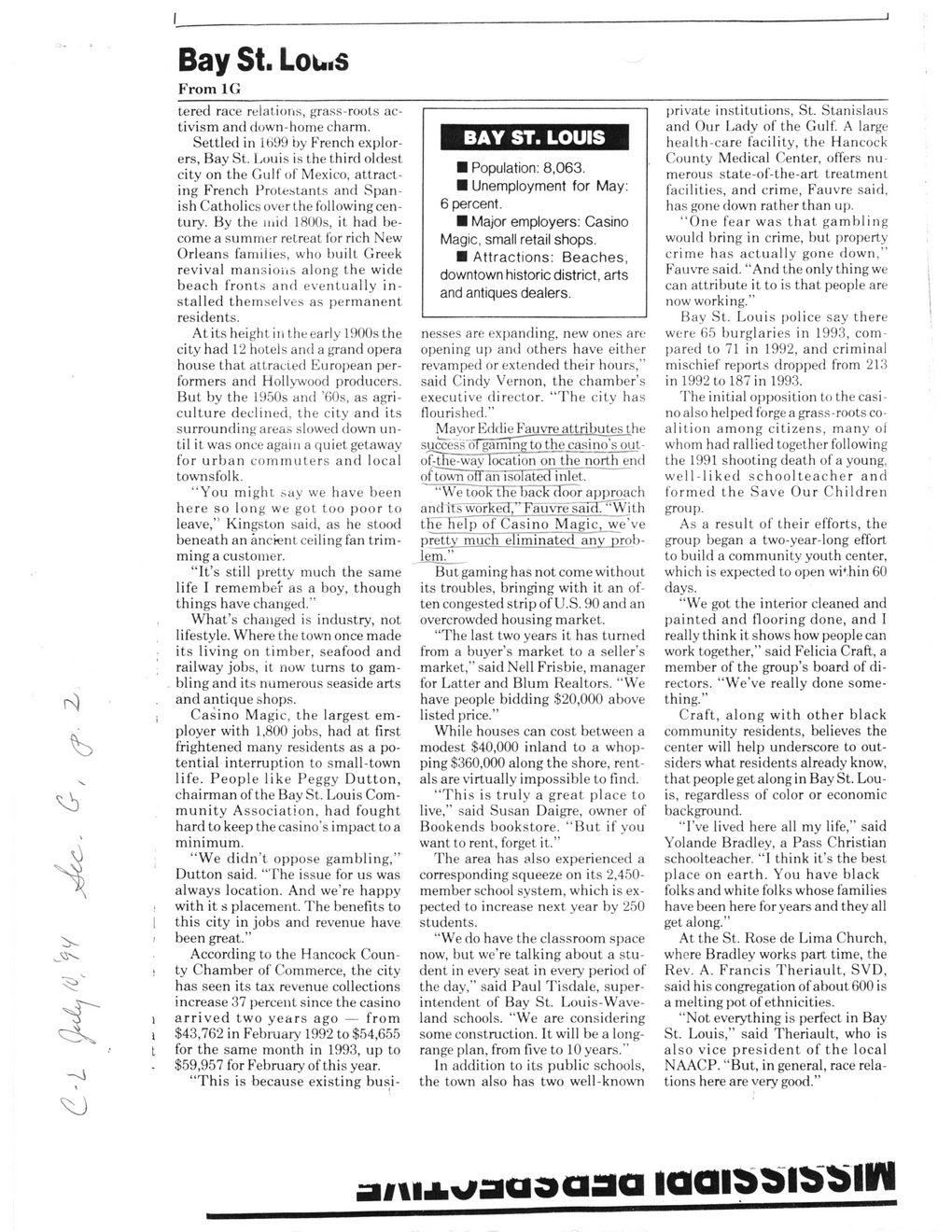This text was obtained via automated optical character recognition.
It has not been edited and may therefore contain several errors.
<b Ssb ^5^ -4 Bay St. Lous From 1G BAY ST. LOUIS ■ Population: 8,063. ■ Unemployment for May: 6 percent. ■ Major employers: Casino Magic, small retail shops. ■ Attractions: Beaches, downtown historic district, arts and antiques dealers. tered race relations, grass-roots activism and down-home charm. Settled in 1699 by French explorers, Bay St. Louis is the third oldest city on the Gulf of Mexico, attracting French Protehtants and Spanish Catholics over the following century. By the mid 1800s, it had become a summer retreat for rich New Orleans families, who built Greek revival mansions along the wide beach fronts and eventually installed themselves as permanent residents. At its height in the early 1900s the city had 12 hotels and a grand opera house that attracted European performers and Hollywood producers. But by the 1950s and ’60s, as agriculture declined, the city and its surrounding areas slowed down until it was once again a quiet getaway for urban commuters and local townsfolk. “You might say we have been here so long we got too poor to leave,” Kingston said, as he stood beneath an ancient ceiling fan trimming a customer. “It’s still pretty much the same life I remember as a boy, though things have changed.” What’s changed is industry, not lifestyle. Where the town once made its living on timber, seafood and railway jobs, it now turns to gambling and its numerous seaside arts and antique shops. i Casino Magic, the largest employer with 1,800 jobs, had at first frightened many residents as a potential interruption to small-town life. People like Peggy Dutton, chairman of the Bay St. Louis Community Association, had fought hard to keep the casino’s impact to a minimum. “We didn’t oppose gambling,” Dutton said. “The issue for us was always location. And we’re happy with it s placement. The benefits to [ this city in jobs and revenue have i been great.” According to the Hancock Coun-! ty Chamber of Commerce, the city has seen its tax revenue collections increase 37 percent since the casino i arrived two years ago — from i $43,762 in February 1992 to $54,655 t for the same month in 1993, up to $59,957 for February of this year. “This is because existing busi- nesses are expanding, new ones are opening up and others have either revamped or extended their hours,” said Cindy Vernon, the chamber’s executive director. “The city has flourished.” Mayor Eddie Fauvre attributes the success ol gainingto the casino’s out -of-the-way location on the north end of town ott an isolated inlet. “We took the back Hoor approach and its worked,’’Fauvre said. “With the help of Casino Magic^we’ve pretty mncl7 eliminated any j)rob-lem.” But gaming has not come without its troubles, bringing with it an often congested strip of U.S. 90 and an overcrowded housing market. “The last two years it has turned from a buyer’s market to a seller’s market,” said Nell Frisbie, manager for Latter and Blum Realtors. “We have people bidding $20,000 above listed price.” While houses can cost between a modest $40,000 inland to a whopping $360,000 along the shore, rentals are virtually impossible to find. “This is truly a great place to live,” said Susan Daigre, owner of Bookends bookstore. “But if you want to rent, forget it.” The area has also experienced a corresponding squeeze on its 2,450-member school system, which is expected to increase next year by 250 students. “We do have the classroom space now, but we’re talking about a student in every seat in every period of the day,” said Paul Tisdale, superintendent of Bay St. Louis-Wave-land schools. “We are considering some construction. It will be a long-range plan, from five to 10 years.” In addition to its public schools, the town also has two well-known private institutions, St. Stanislaus and Our Lady of the Gulf. A large health-care facility, the Hancock County Medical Center, offers numerous state-of-the-art treatment facilities, and crime, Fauvre said, has gone down rather than up. “One fear was that gambling would bring in crime, but property crime has actually gone down,” Fauvre said. “And the only thing we can attribute it to is that people are now working.” Bay St. Louis police say there were 65 burglaries in 1993, compared to 71 in 1992, and criminal mischief reports dropped from 213 in 1992 to 187 in 1993. The initial opposition to the casino also helped forge a grass-roots coalition among citizens, many of whom had rallied together following the 1991 shooting death of a young, well-liked schoolteacher and formed the Save Our Children group. As a result of their efforts, the group began a two-year-long effort to build a community youth center, which is expected to open within 60 days. “We got the interior cleaned and painted and flooring done, and I really think it shows how people can work together,” said Felicia Craft, a member of the group’s board of directors. “We’ve really done something.” Craft, along with other black community residents, believes the center will help underscore to outsiders what residents already know, that people get along in Bay St. Louis, regardless of color or economic background. “I’ve lived here all my life,” said Yolande Bradley, a Pass Christian schoolteacher. “I think it’s the best place on earth. You have black folks and white folks whose families have been here for years and they all get along.” At the St. Rose de Lima Church, where Bradley works part time, the Rev. A. Francis Theriault, SVD, said his congregation of about 600 is a melting pot of ethnicities. “Not everything is perfect in Bay St. Louis,” said Theriault, who is also vice president of the local NAACP. “But, in general, race relations here are very good.”

BSL 1991 To 1995 一Document (06)